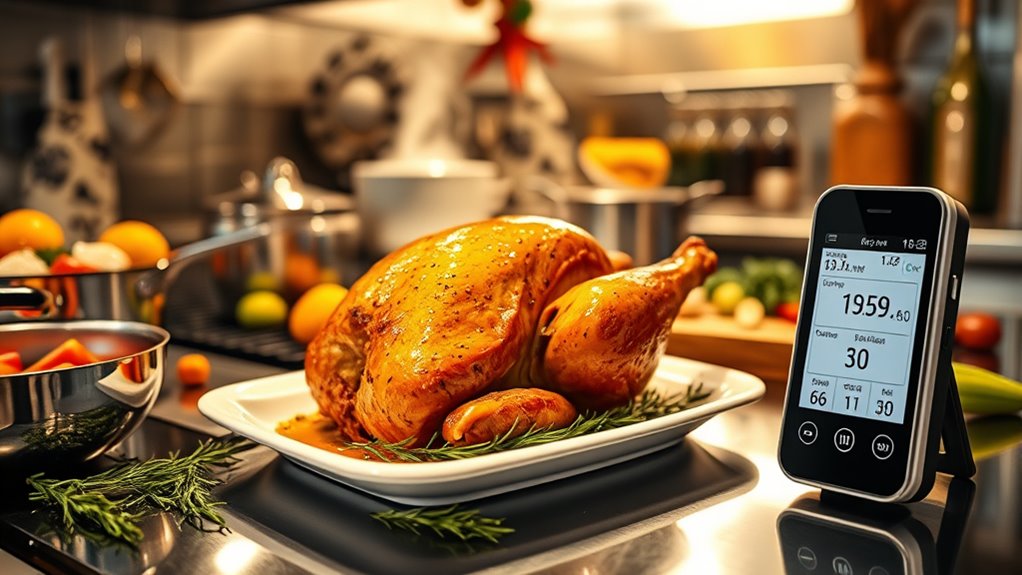To plan for fresh indoor air during holiday cooking, use an odor impact calculator that weighs ventilation options, natural odor absorbers, and scent diffusion tools. It helps you determine the best mix of fans, open windows, air purifiers, and diffusers to minimize lingering smells. By proactively managing these factors, you’ll keep your home welcoming and free from overpowering odors. Keep exploring for more tips to perfect your holiday aroma management plan.
Key Takeaways
- Use ventilation tools like fans and open windows to reduce cooking odors during holiday meal preparations.
- Incorporate odor absorbers such as baking soda or activated charcoal near cooking areas for effective neutralization.
- Deploy scent diffusion devices like essential oil diffusers to distribute pleasant aromas and mask lingering smells.
- Regularly clean cooking surfaces, trash bins, and ventilation filters to prevent odor buildup before guests arrive.
- Combine proactive strategies—ventilation, odor absorbers, and diffusion—to maintain a fresh indoor environment for festivities.

During the holiday season, the delicious aromas from cooking can quickly fill your home, but they also leave behind lingering odors that can be tough to eliminate. You want your space to smell festive and inviting, not overwhelmed by the scent of burnt roast or spices that refuse to fade. That’s where understanding scent diffusion and odor control becomes essential. These strategies help you manage the smell of holiday dishes, ensuring your indoor air stays fresh and welcoming.
During the holidays, manage aromas with scent diffusion and odor control for a fresh, inviting home.
Scent diffusion plays a crucial role in how odors spread throughout your home. When you cook, steam and vapors carry the aroma into every corner, but they can also carry unwanted smells. To control this, you can use fans, open windows, or run exhaust hoods to direct and disperse odors outside. Investing in effective scent diffusion tools, like air purifiers with activated carbon filters or essential oil diffusers, can help evenly distribute pleasant aromas while neutralizing unpleasant ones. These devices work by absorbing or masking odors, preventing them from lingering long after the meal is over. Additionally, choosing the right air filtration methods can further enhance the removal of airborne particles and odors for a healthier indoor environment.
Odor control is essential during heavy cooking days. You might consider using natural odor absorbers like baking soda or vinegar, which can be placed near cooking surfaces or in bowls around your kitchen. These substances trap and neutralize bad smells without adding harsh chemicals. Additionally, regular cleaning of cooking surfaces, trash bins, and ventilation filters can greatly reduce the buildup of odors. The key is to act quickly—ventilate the area immediately after cooking, and consider running a fan or opening windows to encourage fresh air circulation. This proactive approach minimizes scent buildup and prevents odors from becoming embedded in fabric or upholstery.
Planning ahead with a scent diffusion and odor control strategy helps you enjoy your holiday cooking without the worry of overpowering smells. Use a combination of proper ventilation, natural odor absorbers, and scent diffusion devices to keep indoor air fresh. Remember, the goal isn’t just to mask the smell but to actively neutralize it. By doing so, you create an environment where the aroma of holiday treats mingles with clean, crisp air, enhancing the festive atmosphere.
Ultimately, a little preparation and the right tools make all the difference. With effective scent diffusion and odor control, you’ll enjoy the holiday cooking process and come away with a home that smells as joyful as it looks. This way, your guests will be greeted with fresh, inviting air—ready for celebration.
Frequently Asked Questions
How Does Cooking Duration Affect Odor Levels?
The longer you cook, the higher the odor intensity becomes because extended cooking releases more particles into the air. Prolonged cooking time increases odor levels, making your indoor space smell more strongly. To keep odors manageable, try to limit cooking duration when possible and use ventilation fans or open windows. Shorter cooking times help reduce odor buildup, ensuring a fresher indoor environment during the holiday season.
Can Different Recipes Produce Varying Odor Impacts?
Yes, different recipes can produce varying odor impacts because flavor intensity and ingredient sensitivity play significant roles. For instance, strong spices or pungent ingredients like garlic and onions release more intense odors, affecting indoor air quality. You should consider these factors when planning your cooking, especially if you’re sensitive to odors or want to minimize lingering smells. Adjusting recipes or using ventilation can help manage odor levels effectively.
What Indoor Air Quality Improvements Are Recommended Post-Cooking?
After cooking, you should use an air purifier with proven effectiveness to remove lingering odors. Additionally, employ odor absorption techniques like venting the kitchen, placing bowls of baking soda, or using activated charcoal to absorb smells. These methods help improve indoor air quality quickly, ensuring your home feels fresh. Regularly changing air filters and opening windows also enhance air circulation and odor removal, creating a healthier indoor environment.
Are There Specific Ingredients That Cause Stronger Indoor Odors?
Certain ingredients, like spice aroma and seafood scent, produce stronger indoor odors that linger longer. You’ll notice that spicy dishes like curry or cinnamon-based recipes create a warm, fragrant aroma, while seafood can fill your space with a pungent, salty scent. These odors cling to surfaces and fabrics, making it essential to ventilate thoroughly. Using exhaust fans and opening windows can help you clear these stronger smells quickly and keep your indoor air fresh.
How Can Ventilation Be Optimized During Holiday Cooking?
To optimize ventilation during holiday cooking, use effective ventilation techniques like range hoods and exhaust fans to remove odors quickly. Open windows and doors when possible to increase airflow, and run ceiling fans to circulate fresh air. Pair these methods with air purification devices that filter airborne particles and odors, ensuring your indoor air stays fresh and healthy throughout your festive cooking adventures.
Conclusion
By using the Holiday Cooking Odor Impact Calculator, you can effortlessly plan to keep your indoor air crisp and inviting. Don’t let lingering odors turn your festive cheer into a faint memory—take control now. Remember, a gust of fresh air isn’t just a luxury; it’s the foundation of a warm, welcoming home. So, why wait? Act today and guarantee your holiday celebrations are filled with only joy, not unwanted smells.









